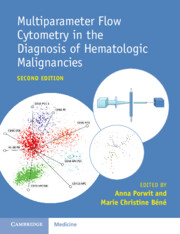Book contents
- Multiparameter Flow Cytometry in the Diagnosis of Haematologic Malignancies
- Multiparameter Flow Cytometry in the Diagnosis of Haematologic Malignancies
- Copyright page
- Contents
- Contributors
- Preface
- Abbreviations
- Chapter 1 Flow Cytometry in Clinical Haematopathology
- Chapter 2 Antigens
- Chapter 3 Flow Cytometry of Normal Blood, Bone Marrow and Lymphatic Tissue
- Chapter 4 Reactive Conditions and Other Diseases Where Flow Cytometric Findings May Mimic Haematological Malignancies
- Chapter 5 Examples of Immunophenotypic Features in Various Categories of Acute Leukaemia
- Chapter 6 Acute Lymphoid Leukaemia and Minimal/Measurable Residual Disease
- Chapter 7 Immunophenotyping of Mature B-Cell Lymphomas
- Chapter 8 Plasma Cell Myeloma and Related Disorders
- Chapter 9 Mature T-Cell Neoplasms and Natural Killer-Cell Malignancies
- Chapter 10 Flow Cytometric Diagnosis of Classic Hodgkin Lymphoma in Lymph Nodes
- Chapter 11 Measurable Residual Disease in Acute Myeloid Leukaemia
- Chapter 12 Ambiguous Lineage and Mixed Phenotype Acute Leukaemia
- Chapter 13 Flow Cytometry in Myelodysplastic Syndromes
- Chapter 14 Future Applications of Flow Cytometry and Related Techniques
- Index
- References
Chapter 14 - Future Applications of Flow Cytometry and Related Techniques
Published online by Cambridge University Press: 30 January 2025
- Multiparameter Flow Cytometry in the Diagnosis of Haematologic Malignancies
- Multiparameter Flow Cytometry in the Diagnosis of Haematologic Malignancies
- Copyright page
- Contents
- Contributors
- Preface
- Abbreviations
- Chapter 1 Flow Cytometry in Clinical Haematopathology
- Chapter 2 Antigens
- Chapter 3 Flow Cytometry of Normal Blood, Bone Marrow and Lymphatic Tissue
- Chapter 4 Reactive Conditions and Other Diseases Where Flow Cytometric Findings May Mimic Haematological Malignancies
- Chapter 5 Examples of Immunophenotypic Features in Various Categories of Acute Leukaemia
- Chapter 6 Acute Lymphoid Leukaemia and Minimal/Measurable Residual Disease
- Chapter 7 Immunophenotyping of Mature B-Cell Lymphomas
- Chapter 8 Plasma Cell Myeloma and Related Disorders
- Chapter 9 Mature T-Cell Neoplasms and Natural Killer-Cell Malignancies
- Chapter 10 Flow Cytometric Diagnosis of Classic Hodgkin Lymphoma in Lymph Nodes
- Chapter 11 Measurable Residual Disease in Acute Myeloid Leukaemia
- Chapter 12 Ambiguous Lineage and Mixed Phenotype Acute Leukaemia
- Chapter 13 Flow Cytometry in Myelodysplastic Syndromes
- Chapter 14 Future Applications of Flow Cytometry and Related Techniques
- Index
- References
Summary
Although the fundamental idea of having cells focalised to be ’seen’ one by one by a detection system remains unchanged, flow cytometry technologies evolve. This chapter provides an overview of recent progress in this evolution. From a technical point of view, cameras can provide images of each of these cells together with their fluorescent properties, or the whole spectrum of emitted light can be collected. Markers coupled to heavy metals allow to detect each cell immunophenotype by mass spectrometry. On the analysis side, artificial intelligence and machine learning are developing for unsupervised analysis, saving time before a much better supervision of small populations.
Keywords
- Type
- Chapter
- Information
- Publisher: Cambridge University PressPrint publication year: 2025

